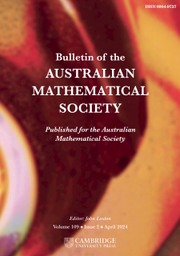No CrossRef data available.
Article contents
RAMSEY NUMBERS OF CYCLES VERSUS MULTIPLE ODD WHEELS
Published online by Cambridge University Press: 01 September 2025
Abstract
Given two graphs G and H, the Ramsey number  $R(G,H)$ is the smallest positive integer N such that every graph of order N contains G or its complement contains H as a subgraph. Let
$R(G,H)$ is the smallest positive integer N such that every graph of order N contains G or its complement contains H as a subgraph. Let  $C_n$ denote the cycle on n vertices and let
$C_n$ denote the cycle on n vertices and let  $tW_{2m+1}$ denote the disjoint union of t copies of the
$tW_{2m+1}$ denote the disjoint union of t copies of the  $(2m+2)$-vertex wheel
$(2m+2)$-vertex wheel  $W_{2m+1}$. We show that for integers
$W_{2m+1}$. We show that for integers  $m\ge 1$,
$m\ge 1$,  $t\ge 2$ and
$t\ge 2$ and  $n\ge (6m+3)t-6m+999$,
$n\ge (6m+3)t-6m+999$,  $$ \begin{align*} R(C_n, tW_{2m+1})=3n+t-3. \end{align*} $$
$$ \begin{align*} R(C_n, tW_{2m+1})=3n+t-3. \end{align*} $$
This result extends several previous results and settles a conjecture posed by Sudarsana [‘A note on the Ramsey number for cycle with respect to multiple copies of wheels’, Electron. J. Graph Theory Appl. 9(2) (2021), 561–566].
Keywords
Information
- Type
- Research Article
- Information
- Copyright
- © The Author(s), 2025. Published by Cambridge University Press on behalf of Australian Mathematical Publishing Association Inc.
Footnotes
The second author was partially supported by the National Natural Science Foundation of China (NSFC) under Grant No. 11601527 and by the Natural Science Foundation of Hebei Province under Grant No. A2023205045.


